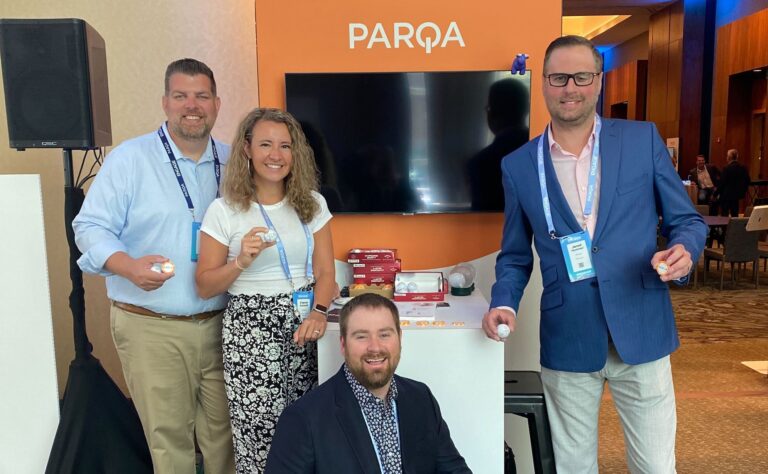Think the sun has set on email marketing’s heyday? Think again.
The truth is that email marketing continues to be a powerful tool for attracting and engaging top talent in the staffing and recruiting industry. In fact, statistics show the effectiveness of solid email campaigns are only growing:
- 77% of marketers have seen an increase in email engagement over the last 12 months.
- For every dollar you spend on email marketing, you can expect an average return of $40.
- Nearly half of consumers said that they would like to receive promotional emails from their favorite brands on a weekly basis.
Not to mention, there are a whopping four billion people who use email every single day. Yowza!
In the staffing world—an industry quite literally centered on human connection—a well-executed email campaign can capture candidates’ attention, build relationships, and ultimately drive successful recruitment outcomes.
At PARQA, we’re big fans of the benefits of email marketing—but only when it’s done right. And with constantly evolving email marketing best practices (especially since AI has come into the picture), it can be a challenge to keep up with the latest.
Wouldn’t it be nice to have a single source of truth for the latest and greatest approaches to knocking your email campaigns out of the park?
Yep. We thought so, too.
In this article, we’ll provide you with valuable email marketing insights, top tips, and best practices to help you create your own highly impactful recruitment emails. (Psst! You’re definitely going to want to bookmark this article for future reference).
First Up: Defining Business Challenges, Solutions and Objectives
Like any successful marketing initiative, it all starts with assessing where you’re at today before executing your strategy.
So, before you even think about putting fingers to keys, your organization’s stakeholders need to answer a few questions:
- What are the challenges, problems, or pain points that your audience is facing that your organization can help them solve?
- What type of email campaign will give the audience the info they need to go deeper into your offering and take action?
- What are the objectives and key performance indicators (KPIs) for this campaign?
Step #1 – Diagnosing Current Challenges, Problems, or Pain Points
Let’s start things off by identifying the challenges, problems, or pain points your organization and your audience are currently facing. Take the time to analyze and understand the specific hurdles that may be hindering your recruitment efforts.
Ask yourself and your team: Are you struggling to attract qualified candidates? Losing candidates during the recruiting and/or hiring process? Or maybe you’re experiencing low response rates to your job postings?
When it comes to your candidates, are they struggling to find a permanent career fit? Or perhaps they’re craving more frequent communication from their recruiter? After all, Bullhorn’s 2023 Grid Talent Report confirms that email is the communication method of choice during the hiring process—and while on assignment.
By diagnosing these challenges, you can tailor your email campaign to address them directly and provide solutions that resonate with your audience.
Step #2 – Identifying the Right Type of Email Campaign
Once you have a clear understanding of the challenges you’re facing (and solving for your audience(s)), it’s time to determine the type of email campaign that will work best.
Fortunately, there are many approaches to choose from, depending on your objectives and target audience.
For example, if your goal is to nurture relationships with passive candidates, a “drip” campaign that delivers a series of highly consumable targeted emails over time may be the ideal approach. Or, if you’re looking to promote specific job openings and attract active candidates, a targeted recruitment email campaign with personalized job recommendations might be more effective.
By aligning your email campaign type with your objectives, you can create a focused and impactful strategy right off the bat—and avoid the need to overhaul or scrap your plan down the road.
Step #3 – Defining Objectives and KPIs
Lastly, key stakeholders within your organization will want to define clear objectives and KPIs to measure the success of your recruitment email campaign.
What do you want to achieve with your campaign? Do you aim to increase the number of applications received, improve candidate engagement, or boost your conversion rates? Setting specific and measurable objectives will guide your campaign strategy and allow you to track your progress effectively.
Then, establishing relevant KPIs will enable you to monitor email performance and make data-driven decisions to optimize your campaign over time. You’ll want to keep these KPIs realistic and aligned with your overarching goals so that you can set your team up for success and create the space to experiment, observe, learn and refine.
Best Practices for Crafting Effective Recruitment Emails
Now that we’ve covered the bases for assessing where your organization is currently, identifying the challenges you need to solve for both your business and your audience, and establishing the success measures you’ll track for the campaign, it’s time to get writing.
When it comes to email, every word counts. So it’s essential to understand and implement email marketing best practices to ensure a successful campaign.
Let’s cover them now.
Best Practice #1 – Personalization and Segmentation
Personalization and segmentation are hands down two of the most impactful elements of a successful email campaign—when done right, that is.
The average email open rate without personalization is 20.81%. But the simple act of strategically sprinkling in some personalization to your subject line will give a major boost to your email open rates. In fact, emails with personalized subject lines generate 50% higher open rates, making it well worth the effort. Therefore, email personalization is a nonnegotiable capability to bring in house when choosing an email marketing platform. (May we suggest Bullhorn? 😉)
When it comes to segmentation—the organizing of email marketing subscribers into sub-groups based on specific criteria—HubSpot research shows that this is the single most effective email marketing strategy—period.
Here are some specific tactics to employ, every time:
Personalization best practices:
- Ditch the formalities: Your email copy should be friendly and personable, regardless of the industry. Leave jargon at the door and opt for a clear and relatable tone. Use the words and phrases your audience will recognize and connect to.
- Stay relevant: Tap into the data you gather about your customers to deliver content they didn’t even know they needed. Be the trusted thought leader who shares valuable insights, tips, and resources that truly benefit them and reflect your deep understanding of their journey and challenges. Keep it relevant, helpful and engaging. Make them the “hero” of the story with your firm by their side. Your recipients will appreciate and respond to the personal touch. It shows that you’re walking in their shoes rather than just telling them how great you are.
- Inject some humor: Break the ice by adding a touch of humor or lightheartedness if it makes sense for your brand voice and tone. This will endear your audience, break through the inbox clutter, and help your firm stand out as a trusted expert—not just another transactional staffing firm.
Segmentation best practices:
- Choose the right email tool for segmentation: When it comes to effectively segmenting your email list, it’s crucial to select the right email marketing platform that offers robust segmentation capabilities. Look for a tool that allows you to easily create and manage segments based on specific criteria, such as job roles, industries, geographic locations, or engagement levels. A powerful email tool will enable you to personalize your messages and target the right audience with relevant content, ensuring maximum impact and engagement.
- Keep it simple, staffing pros: When implementing segmentation strategies, aim for simplicity and clarity in your segment criteria. Avoid creating overly complex parameters that may be difficult to manage or understand. Instead, focus on key factors that are most relevant to your recruitment goals and target audience. By keeping your segments simple and well-defined, you’ll have better control over your email campaigns and deliver more tailored and effective messages to your recipients.
- Make sure your data is “clean:” Like we discuss here, accurate and reliable data is the cornerstone of success for staffing and recruiting professionals—especially when it comes to candidate comms. Schedule quarterly data-cleanup days to remove duplicates, correct inaccuracies, and update contact information. By maintaining a clean, organized and reliable database, you can confidently segment your audience and deliver personalized emails to the right individuals at the right moments. Clean data not only improves the efficiency and effectiveness of your email campaigns, but it also enhances your brand reputation and strengthens your relationships with candidates.
Best Practice #2 – Compelling Subject Lines and Preheaders
When it comes to email marketing, the subject line and preheader are your first and sometimes only chance to grab your recipients’ attention—especially since the average time people spend reading an email is just 12 seconds.
What better way to make the most of that precious window of time than with a great subject line and preview text (also known as a “preheader” available in many automation tools).
Crafting compelling subject lines and preheaders is essential to increasing open rates and enticing your audience to engage with your emails.
Here are our top tips for crafting both:
Subject line best practices:
- Make them concise, clear and compelling: One of the best ways to do this is by incorporating stats and numbers.
- Avoid generic or spammy phrases, like the 200ish listed here.
- Focus on personalization and relevance, as we mentioned in the section above.
- Garner immediate attention with power words, questions, or by creating a sense of urgency or “FOMO” with a deadline or social proof.
What’s with the preheader?
In addition to compelling subject lines, don’t overlook the importance of preheaders. As a powerful complement to the subject line, preheaders provide an at-a-glance inbox preview of the email’s content. Think of it as bonus eye-catching real estate for your words.
Preheader best practices:
- Focus on the benefits to your “user:” Offer a glimpse into the value or benefit recipients will gain by opening the email and working with your firm.
- Keep ‘em short + sweet: Craft a concise and engaging preheader that entices them to dive deeper into the email and explore what you have to offer.
- Pair the preheader with a strong subject line: Increase the chances of your email being opened and read with this one-two punch. For instance, if your subject line is a viral question (i.e., “What if your talent network was a thriving community?”), tease it out further with a clever preheader that sparks curiosity and reinforces the idea (i.e., “Talent pools are so over.”).
Best Practice #3 – Engaging Email Content
When it comes to crafting engaging email content, we want to keep it clear and concise, delivering a message that captures the attention of our recipients.
Email marketing falls into the short-form content category, so every word, every character, and even every punctuation mark counts. Packing as much punch and value as possible in the fewest words? Now that is truly an art form.
Email content best practices:
- Be concise: According to Boomerang, emails between 50 and 125 words had the best response rates at just above 50%.
- Write for a third grader: Yep, you read that right. Boomerang’s study also showed that emails written at a third-grade reading level had the highest response rate. These emails performed 36% better in terms of open rate than those written at a college reading level and boasted a 17% higher response rate than emails composed at a high school reading level.
- Informal is best: Data shows that informal emails with a conversational tone are best for eliciting a response from recipients.
- Mix up your media: Some of your emails should be copy-driven, some should be more visual, and some should merely tee-up value-added content like a video or podcast. Provide multiple ways for your audience to get the key concept, and keep in mind that some people like to read, others are more visual, and some learn best by listening to a podcast or watching a webinar. Pay attention to your performance data to understand which content your readers are engaging with and tailor it to their behavior from there.
- Put yourself in the reader’s shoes: Think about what your reader truly needs and wants from your organization. Are you offering them valuable insights, career advice, or updates on job opportunities? We want to provide content that addresses their specific needs and challenges, empowering them to take the next steps in their career journey and offering them value all the way. Avoid email campaigns that simply tell your audience about your firm. Like most of us, they want to quickly understand what’s in it for them, or they’ll bounce.
Best Practice #4 – Call-to-Action (CTA) Optimization
CTAs are the driving force that compels recipients to take the desired action, whether it’s applying for a job, scheduling an interview, or exploring more opportunities on your website. Basically, don’t leave ‘em hanging. Map out the exact action you want your readers to take next to lower their “barrier to entry.”
CTA best practices:
- Use action-oriented language: Compelling CTAs are simple, to-the-point phrases that capture the attention of your recipients with action verbs. For example: “Apply Now,” “Discover Opportunities,” or “Start Your Journey.”
- Avoid ambiguity: People thrive on predictability. They like to know what to expect next—even when it comes to the seemingly simple click of a button. CTAs that are optimized for high conversions are clear, concise, and hard to resist. This isn’t a place to get cutesy or clever for the heck of it. Clear and actionable are the winners here.
- Incorporate pre-CTA copy: Consider adding some brief “explainer” copy that makes it clear to the reader where the link will take them, what to expect when they get there, the next steps they’ll take, or the level of commitment or effort required. For example, if your CTA is to take a survey, let your audience know how long it will take them with “Take Our 2-Minute Survey.” Or, if your CTA designed to help them apply, set an expectation for when they can expect to hear back.
- Place them strategically: Position CTAs prominently so that they’re easily visible and accessible. Consider placing CTAs “above the fold,” (i.e., the top half of the email) so that they’re immediately visible. And reinforce CTAs by repeating them throughout the email for multiple opportunities to take action.
Best Practice #5 – Mobile-Friendly Design
Designers, this one’s for you. Mobile-friendly email design is the last piece of the puzzle when it comes to email marketing best practices.
Of the 2.6 billion email users globally, 1.7 billion of them are checking their inbox on a mobile device, while less than one billion of them do so on a desktop. That’s 65% of people—and likely, an even higher percentage of the professionals in your candidate community. Clearly, mobile-friendly design is another nonnegotiable aspect of successful email marketing.
Email design best practices:
- Use a responsive email template: Make sure your emails look fantastic on any device with mobile templates that automatically adjust the layout and formatting for different screen sizes and give users a seamless experience no matter the device. And if your email service provider doesn’t have mobile-friendly templates, we highly recommend investing in a custom design.
- Design for mobile devices first: If you want your emails to get read, then not just mobile-friendly, but mobile-first design should be high on your priority list. Keep in mind that 62% of people will delete an email if it’s not mobile-optimized. Instead of designing for desktop first, it’s more beneficial (and easier for your designer and developer) to start by designing a mobile version of your email templates. Get the full scoop on the benefits of mobile-first in this article from Dyspatch.
- Format content for easy scanning: Mobile users tend to skim through emails rather than reading every word. For the skimmers on your list, you’ll want to highlight the most important information and make it easily scannable. That way, your recipients can quickly grasp the key points even if they’re just giving the email a quick glance.
Enlist the Email Marketing Experts at PARQA for Your Recruitment Email Strategy
Don’t let your recruitment emails fall flat. Take advantage of the power of email marketing to attract top talent, nurture relationships and drive successful placements. Start implementing these best practices today to see the difference they can make in your recruitment efforts.
And if you’re not into the DIY approach, that’s where PARQA comes in. Our team of digital marketing experts have created dozens of high-converting recruitment email campaigns for our staffing clients across several different industries. From manufacturing and construction to banking, insurance and everything in between, we know a thing or two about how to leverage email to your (and your candidates’) benefit.
Ready to take your recruitment strategy to the next level? Get started by checking out our Automation Content Starter Guide for more email marketing tips, insights, and keywords, subject lines, preview texts, body copy and calls to action (CTAs) to try out!
Or, if you’re ready to bring in reinforcements, get in touch with us today.







